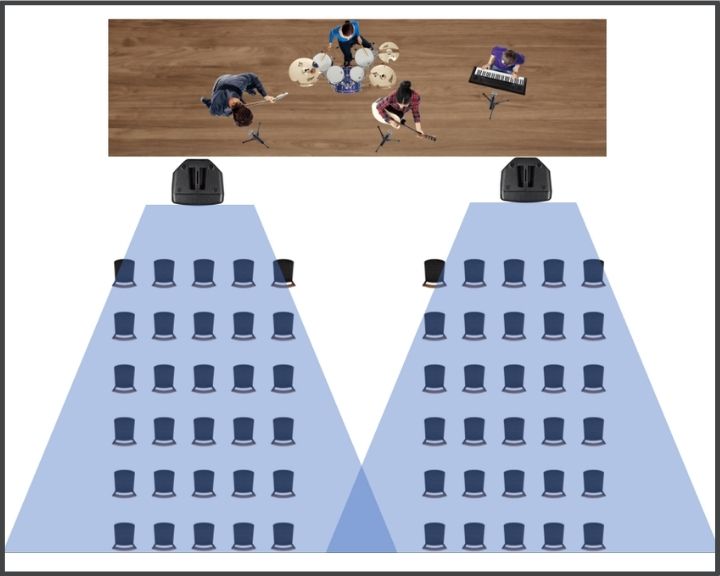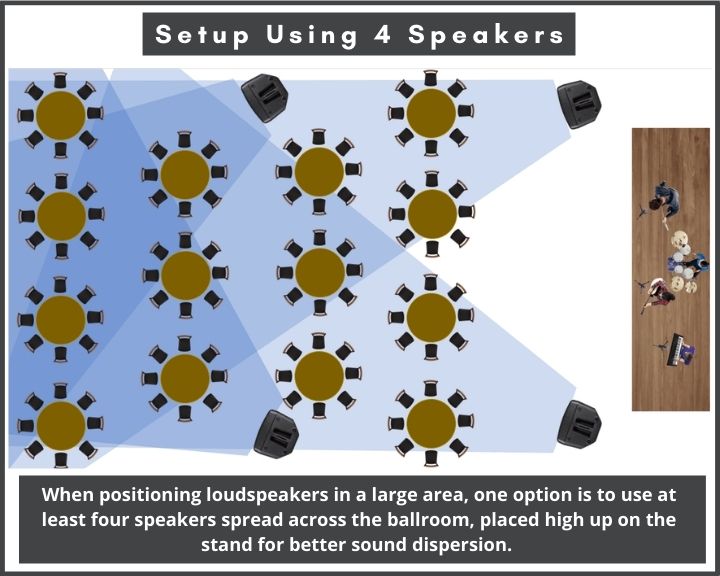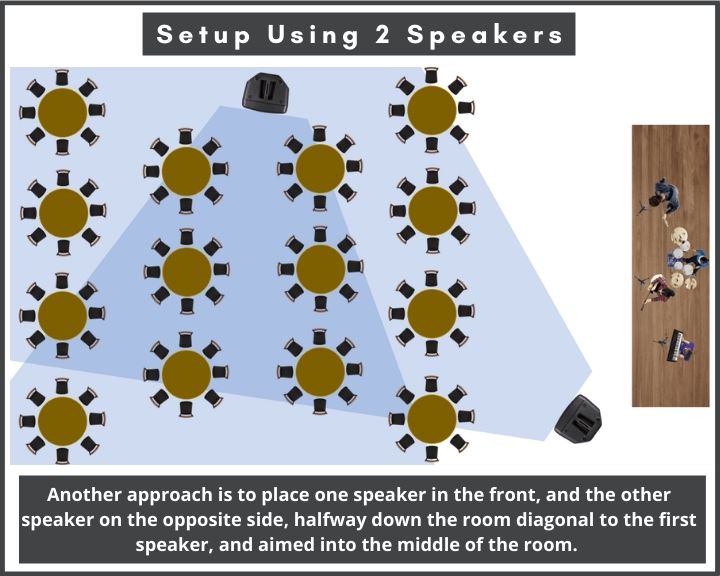When setting up a sound system for a party, wedding, or live performance, it is critical to choose the correct position for the PA speakers to deliver a pleasant experience to the audience.
Positioning the loudspeakers in the right way is not only going to make the setup easier, but it will also solve many acoustic related problems, including feedback.
In this post, I will present a few tips on how to position PA speakers in the right place so that you avoid the most common problems in live setups. Let’s get started with this speaker positioning guide.
Speaker Positioning Guide
Here are some practical tips that will help you get the best results when positioning PA speakers:
- Place the speaker forward, away from the nearest microphone
- Don’t place the speakers in corners or next to walls
- For better sound dispersion position speakers high Up
- In big spaces place speakers in a diagonal manner to cover more area
- In echoey places, position loudspeakers high up angled down towards the audience.
For a detailed explanation of each one of these tips, continue reading.
How to Decide Where to Position PA Speakers
The first step in correctly deciding the placement of PA speakers is to inspect the location where you need to set up the sound system. Check where the stage is located, sum up the size, acoustics, and where the audience is going to be in the room.
One of the most typical problems in large rooms is that the stage ends up being too far from the people sitting in the back. This creates the problem of having to increase the volume making it too loud for the people closest to the stage.
Another problem you could face is the acoustics of the room. For example, the worst acoustics for setting up a sound system is a gymnasium. There you have high ceilings and no absorbing material such as carpet to prevent the sound from bouncing back and forth, creating a lot of echo.
Furthermore, a critical component for deciding where to position the speaker is where the microphones are going to be located. You don’t’s want to have to deal with feedback, and devising a plan ahead of time is going to save you a lot of trouble.
Tip # 1 – Place the Speaker Forward, Away From the Nearest Microphone to Avoid Feedback
The main reason for audio feedback in live setups is placing the speakers and microphones too close to each other, or at the wrong angles.
If loudspeakers are placed behind the microphones, feedback is almost guaranteed because whatever sound comes out of the speaker will be captured by the mic, and the loop will cause feedback.
Another bad idea is to place the speakers to the side of the microphones. The reason is that mics can pick up sound at about a 60-degree angle from the center, that’s why you want to make sure to direct microphones away from the main speakers to avoid feedback.
The Solution
To help reduce the occurrence of feedback, place all open microphones behind the loudspeakers, making sure that there is enough distance between the mic and the speakers.
A rule of thumb commonly used by sound engineers is to double the distance between a microphone and the speaker. That way, the volume of the mic can be increased by 6dB, providing you with more volume headroom before feedback.
When setting up your mics, make sure to allow enough time to try different positions until you get the best results. With time and practice, it will become easier because you will understand the behavior of your sound equipment. Click the link to learn more about what causes microphones to feedback and how to avoid it.
If you need to add stage monitors to your setup, placing them in the correct position is another critical issue you need to deal with. Read about setting up stage monitors by clicking on the link.

READ: How to Set Up a Stage Sound System
Tip # 2 – Don’t Place the Speakers in Corners or Next to Walls
Another typical mistake when setting up PA systems is to place the speakers on a corner right where two walls meet. By doing so, the sound will be excessive around 125 Hz, resulting in annoying low-frequency resonances that will make it very hard to understand what is coming out of the speaker.
If instead the speakers are placed up against the wall, the sound will hit the wall and create an echo that’s not pleasant to hear. The acoustics created by the bouncing waves could also sound bloated depending on the room, which means that the sound will be excessive on frequencies around 250 Hz.
The Solution
When placing speakers in a room, make sure that they have enough space away from the walls and corners, no less than 2 feet. That way, the sound can be projected better, reducing the number of waves that bounce back immediately after leaving the speaker.
READ: Differences Between Active and Passive Speakers
Tip # 3 – To Get Better Sound Dispersion Position the Speakers High Up
Good sound dispersion throughout the venue is critical when positioning PA speakers. A usual mistake when setting up a sound system by amateurs is not to raise the speakers high enough to clear the heads of the audience.
Many times PA speakers are placed at the same height as the audience members creating acoustic problems.
The problem of not having good sound dispersion is that the audience sitting closer to the speakers are going to absorb most of the sound waves, and the people sitting at the back will not hear as clear as those sitting on the front.
An amateur would think that to solve the problem, all that’s needed is to increase the volume. That’s a terrible solution because those sitting in the front will complain about the higher volume.
The Solution
To get good sound dispersion, all you have to do is raise the speakers high enough so that they carry the sound over the people’s heads. With this setup, sound waves will travel across the room without being absorbed by the audience sitting in the front, and everyone will hear a beautiful clear sound.
Mounting the speakers high up creates a risk for the stand to lose balance and trip over if it is not robust. Make sure you get high-quality speaker stands that are sturdy enough to carry the weight of the speaker without tripping over. Remember, you need to take into consideration the safety of the people walking around the venue.
READ: Tips to Stop Mic Feedback in a Small Room
Tip # 4 – For Big Spaces Place Speakers in a Diagonal Manner Facing Away from the Microphones
There are some situations where the setup is for big places like hotel ballroom. For these types of locations, the regular configuration where you position the PA speakers in the front is not going to work.
The reason is because the volumes would need to be increased to a point where feedback is going to be an uncontrollable problem.
Also, by increasing the volume, people sitting closer to the speakers will feel uncomfortable, and those seated at the back of the room will not appreciate the sound intelligibly.
The Solution
For this situation, you have two options. The first is to use at least four speakers spread across the ballroom, placed high up on the stand for better sound dispersion. As shown in the image below.

The second option is to place one speaker in the front, and the other speaker on the opposite side, halfway down the room diagonal to the first speaker, and aimed into the middle of the room. As shown in the following image.

Any of the two options mentioned here are ideal for covering a large room without having to increase the volume to a point where feedback and other acoustic problems start to appear.
If you decide to go with the first option, you would have to connect four speakers to a mixer, and longer cable runs would be needed to send the signal across the room.
I recommend using powered speakers for better results. The good news is that there is an option to connect speakers wirelessly, click the link to read the article on how to do so.
READ: How to Connect 4 Powered Speakers to a Mixer
Tip # 5 – In Echoey Places, Position Loudspeakers High Up, Angled Down Towards the Audience
As mentioned previously in the article, setting up a PA system in echoey places is tricky. Such is the case of a gymnasium or large auditorium without acoustic treatment.
Areas with high ceilings, flat walls, and hard surfaces create a lot of echo. The sound in such places is muddy, lacking clarity, producing weak harmonics, and smeared time response.
The Solution
There is not much to do when dealing with echoey places and positioning PA speakers. The best approach is to position the loudspeakers as high as possible, then angle them down, pointing towards the audience.
This approach directs the sound straight to the audience, using them to absorb the waves minimizing a bit the echo. It also provides you with the option of lowering the volume to reduce the waves from bouncing back and forth.
Allow enough time to experiment and get familiar with the acoustics of the venue, especially if you are dealing with a large echoey place. See how the system reacts to the space when using microphones and different sound sources.